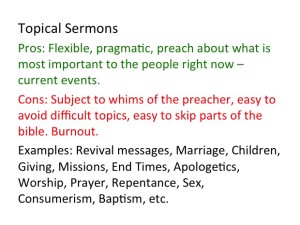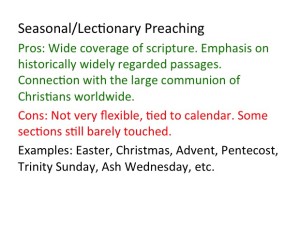OK, so that’s why we have preaching in church and why it’s such a big deal.
But that’s only half on an explanation. How are sermon’s put together anyway? How do they get cooked up? Is there a secret book that pastors own that tells them most of what to say each week? No, they pretty much have to read the bible and make something up from scratch every time.
How something is taught will vary a lot by the audience. How many of you in here are Americans? White collar and sit at a desk all day? Blue collar or service industry? How many here are married? How many have kids? How many grew up a Christian? How many only came to Christ after you were an adult? How many here finished high school? College? How many have a master’s degree or doctorate?
Loren, who is in charge of preaching here, has often told me that the hardest part of preaching at Bridge is the diverse audience. To do a good job you have to have something for everyone. There are enough people in the room that are new Christians and who are not particularly familiar with the bible that you can’t make a bunch of references to other parts of scripture without explaining them. On the other hand, you can’t make everything too basic, or the old-timers will be bored to tears and might have a hard time paying attention, even if you have something really important to say.
In medieval times, there were no books, nobody owned a bible, and maybe nobody in the congregation could even read! Now, everyone owns a bible, has read much of it for themselves, and might even have a whole bookcase of spiritual books at home. Preaching looks very different around the world depending on the nature of the congregation.
Here, we all have cars and can get to church (and back home) in just a few minutes. In Africa, you might hear a really long sermon lasting a couple of hours. That is because most of the people had to walk all morning long just to get into the village and to church! Once they are there, they don’t want to turn around and go back home too soon. That context shapes things too.
Here at this church, we rotate preachers a lot and you’ll notice that the styles really vary. Kim likes to use a lot of scripture references and will often bring in lots of supporting passages from outside the chosen section of the day. Kirk and Luke like to tell stories that people will remember. Loren and I like to bring in elements of church history or philosophy. Geoff’s are usually funny and have lots of visual illustrations. Martin and Bret have their own unique approaches too. Most of these are not so much intentional as just a reflection of the personality of the speaker and how they think about the world. Everyone has a different group of people in the room they connect with better than others. That’s a good thing!
Now, who decides WHAT actually gets preached on every week? There are lots of different ways to approach a sermon, but I’m going to break it down into three main approaches: Topical, Expository, and Seasonal.
(Slides)



